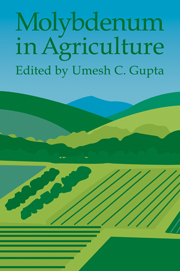Book contents
- Frontmatter
- Contents
- List of contributors
- Preface
- 1 Introduction
- 2 Chemistry and Mineralogy of Molybdenum in Soils
- 3 Distribution and Mobility of Molybdenum in the Terrestrial Environment
- 4 Biochemical Significance of Molybdenum in Crop Plants
- 5 Soil and Plant Factors Affecting Molybdenum Uptake by Plants
- 6 Analytical Techniques for Molybdenum Determination in Plants and Soils
- 7 Testing for Molybdenum Availability in Soils
- 8 Molybdenum Availability in Alkaline Soils
- 9 Deficient, Sufficient, and Toxic Concentrations of Molybdenum in Crops
- 10 Symptoms of Molybdenum Deficiency and Toxicity in Crops
- 11 Sources and Methods for Molybdenum Fertilization of Crops
- 12 Yield Responses to Molybdenum by Field and Horticultural Crops
- 13 Responses of Forage Legumes and Grasses to Molybdenum
- 14 Molybdenum and Sulfur Relationships in Plants
- 15 Molybdenum in the Tropics
- Index
9 - Deficient, Sufficient, and Toxic Concentrations of Molybdenum in Crops
Published online by Cambridge University Press: 10 December 2009
- Frontmatter
- Contents
- List of contributors
- Preface
- 1 Introduction
- 2 Chemistry and Mineralogy of Molybdenum in Soils
- 3 Distribution and Mobility of Molybdenum in the Terrestrial Environment
- 4 Biochemical Significance of Molybdenum in Crop Plants
- 5 Soil and Plant Factors Affecting Molybdenum Uptake by Plants
- 6 Analytical Techniques for Molybdenum Determination in Plants and Soils
- 7 Testing for Molybdenum Availability in Soils
- 8 Molybdenum Availability in Alkaline Soils
- 9 Deficient, Sufficient, and Toxic Concentrations of Molybdenum in Crops
- 10 Symptoms of Molybdenum Deficiency and Toxicity in Crops
- 11 Sources and Methods for Molybdenum Fertilization of Crops
- 12 Yield Responses to Molybdenum by Field and Horticultural Crops
- 13 Responses of Forage Legumes and Grasses to Molybdenum
- 14 Molybdenum and Sulfur Relationships in Plants
- 15 Molybdenum in the Tropics
- Index
Summary
Introduction
Among the micronutrients essential for plant growth, molybdenum (Mo) is required in the smallest amounts. In most soils, the Mo requirements of plants can be met by liming the soil. Because of its low requirement, the deficiency and sufficiency concentrations of Mo in most plants are extremely small. Molybdenum toxicity to plants under field conditions seldom occurs, and usually it can be induced only under extreme experimental conditions (Johnson, 1966). Therefore, this chapter does not place great emphasis on the toxic concentrations of Mo in plants. However, plants can, under certain conditions, accumulate large concentrations of Mo and induce molybdenosis in ruminants that eat such material. That will be dealt with in Chapter 15.
The precision of modern analytical methods is such that even microquantities of Mo in plants can be detected accurately, and considerable data have accumulated over the past 40 years regarding Mo concentrations in a number of plant species. The purpose of this chapter is to report the sufficient, deficient, and toxic concentrations of Mo in a number of cultivated crop species as found by workers around the world.
Usually when one talks about the deficient, sufficient, and toxic concentrations of nutrients in crops, there is a range of values, rather than one definite number that can be considered as critical. Therefore, use of the term “critical” in crops is somewhat misleading. A nutrient concentration considered critical by workers in some areas may not be critical under conditions in other areas.
- Type
- Chapter
- Information
- Molybdenum in Agriculture , pp. 150 - 159Publisher: Cambridge University PressPrint publication year: 1997
- 12
- Cited by



